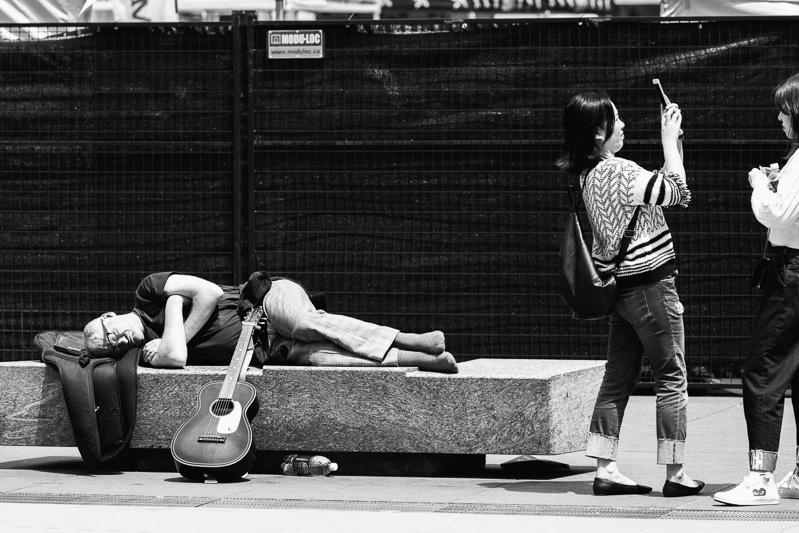Revisiting last Saturday and my wait on Yonge Street for the arrival of the World Naked Bike Ride, my subsequent review of images prods me to reflect on something quite apart from cycling T & A. I was standing on the west side of Yonge Street, roughly in line with the stretch of sidewalk on the east side where tourists line up to catch the double-decker bus for a ride around the city. There is a stone bench nearby. A man, presumably homeless, was lying on the bench, head resting on a soft guitar case while the guitar sat on the ground, propped against the bench. Two Asian women, presumably tourists, stood nearby. The one was trying to position herself to take a selfie with the homeless man in the background. I began to track the interaction through my viewfinder. It’s rare that I shoot on the street with my 70-200 mm zoom lens, but had taken it with me specifically to shoot naked bike riders whizzing past. However, it came in handy when capturing this moment.

For me, as a street photographer, shooting a homeless person is an ambivalent act. It plays along a line of tension between the need to document lived conditions and the need to protect our most vulnerable citizens from exploitation. As our missionary forebears demonstrated, it’s often difficult to tell the difference between compassion and colonization. It’s a tension I agonize over as I curate my own images and, as I see it, it’s a tension that is irresolvable. Even with those photos I choose to share, the tension persists and is transferred to my viewers who must then ask of themselves: how am I seeing the person shown here? What narratives am I assuming? Lazy? Deserves it? Victim? The poor will always be with us? Indolent? And so on. I try to have a compassionate regard for those who appear in my photographs, but always—and especially when these nattering assumptions pop into my head unasked for—I suspect my images are really all about me. My best self wishes it weren’t so, but my human self knows better.
But shooting a photo of someone taking a selfie with a homeless man in the background is a photo of a different order. I feel it’s imperative to capture such an image. It speaks to the mood of our times. It’s something I can thrust into the future with the hope that those who follow me will examine with clearer eyes than mine. Proximity makes me blind. I can hardly say what kind of interaction is passing in this scene.
Today’s proliferation of cameras is understandable. We rush headlong into a future characterized by technological disruption and sensory overwhelm. (No doubt, should anyone in years to come read my last sentence, they might say: you had no idea!) The camera mediates experience; it protects us from the overwhelm. The camera functions like a set of teeth; it chews reality into bite-sized chunks that are easily digestible.
The problem with a device that mediates reality is that it mediates reality. What once seemed real to us now seems constructed. It’s fake news. We witness joy. We witness suffering. But neither touches us anymore. These expressions belong to our constructed world, like a show on Netflix, or pornography, mediated to us through our lenses and image sensors and Instagram filter effects.
A tourist sees a homeless man lying on a bench. Her immediate response is to pose for a selfie with the homeless man lying in the background. He has become a fixture, like the bench itself, in the urban landscape. His presence in the selfie authenticates the tourist’s visit by providing a measure of grittiness that, ironically, makes the experience appear more real. She posts the image to her social media accounts to affirm to friends and acquaintances that her life is real. Certainly more real than theirs. But what remains conspicuously absent from the image is any evidence of an experience. No interaction. No conversation. No attempt to relate. Experience has been gutted, like a fish for sale in St. Lawrence Market.